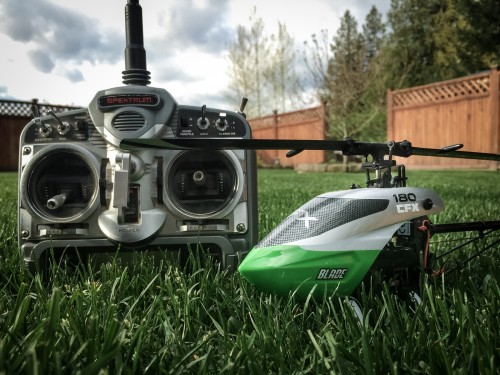
Blade 180CFX Review
Written By Jessie Salmonson
First off I want to give a huge thanks to Blade Helicopters and Horizon Hobby for the opportunity to do a review on the Blade 180CFX. This is the first micro review I have done and one of the first micro helis I have owned. We all know that in recent years these little helis have been making leaps and bounds to try and close the gap between micros and larger collective pitch helis. The Blade 180CFX really seems like a game changer with all the features it brings to the table. Coming from a fleet of mostly 700 sized helis this little guy had some big shoes and expectations to fill. But judging from what I have seen so far I think it’s up to the challenge.
What’s in the box
The first thing I noticed as soon as I opened the box is that the heli is completely assembled and nearly ready to go. In the box you will find the completely assembled Blade 180CFX, a 450mah 30C 3s lipo, some small allen keys, bind plug, and of course an instruction manual. Given the fact that the heli is already assembled you really don’t need many tools to get this thing in the air…well actually no tools.
The heli comes tightly packaged in a Styrofoam cutout that ensures the heli can’t move around during shipping. For some I can even see the box being a carrying case which would be perfect to transport the heli back and forth from the field. Personally for me I won’t use it as a case but I can see someone getting a lot of mileage out of that box.
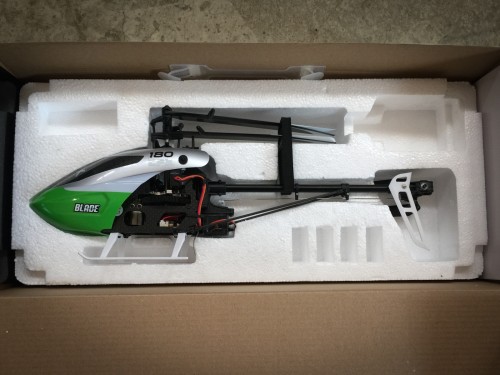
First I want to talk about some of the main features this heli has to offer. To start the blade 180CFX has carbon fiber frames and a tail that is torque tube driven. In features rotating digital servos and Blade’s AS3X Technology with piro compensation. Lastly it includes a brushless motor and a Castle Creations 15 Amp Talon ESC. I have to say all of this is pretty impressive considering the size and the price.
Overall this heli is 340mm in length and uses 154mm blades. It comes in at a ready to fly weight of 200 grams. The selling price for this heli is only $229 which if you ask me is extremely reasonable. It seems like anymore you can’t buy anything for less than $250.
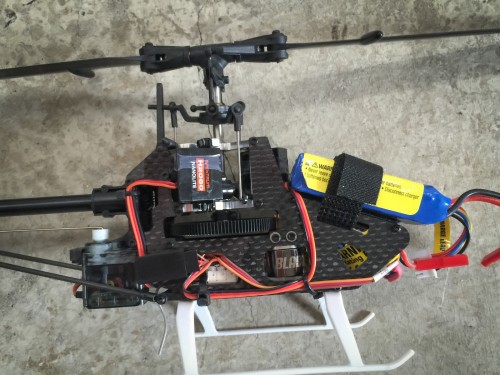
Now that the heli is out of the box and sitting on the bench it’s time to program! When it comes to programming I really don’t think that Blade could have made this any easier. All you need to do is look through the manual and choose the radio you plan to use. At this point the programming is very straight forward since all of the settings are listed. For this review I am using an old DX7 so I chose that transmitter and started entering settings. Once all the settings have been entered the heli is programmed and ready to go. Now I was honestly amazed at how simple it was to burn through the programming and couldn’t believe I was nearly ready to fly this heli only about 30 minutes after opening the box.
At this point the manual became very important and there are numerous sections that walk you through binding up to the first take off. Overall nothing was too complex but you do want to make sure that you read the manual and stick to it so you can avoid any issues. One thing I want to point out is how important it is to do all of the preflight checks especially before the first flight. Simple things like checking the direction of the flybarless system can save you from an unnecessary crash.
With the heli all programmed and successfully bound to the transmitter it’s time to charge up the battery and fly this thing!
First Flights
I must admit that I really wasn’t expecting much from this little guy but oh boy was I in for a surprise. The first thing I noticed when I went to spool this heli up is how high the head speed is. By flying a 700 class heli I really got used to about 2000 rpm or 3100 on the Warp 360. For the Blade 180CFX when you set the throttle curve to 100% this will give you an impressive 5000 RPM on the head. My first thought is that I would do a little test flight in the garage but as soon as I spooled it up I decided that wasn’t a good idea.
This brings me out to the flying field where the actual first flight happened. Right off the bat I was very impressed with both the responsiveness and the stability of this heli. You would think that since it’s so small it would be pretty squirrelly, but this just wasn’t the case at all. I should note that I left all of the rates at 100% for the head and tail, and didn’t use any dual rates. For me this was just about perfect, I could easily flip and roll the heli and had enough cyclic control to not be chasing the thing all over the place.
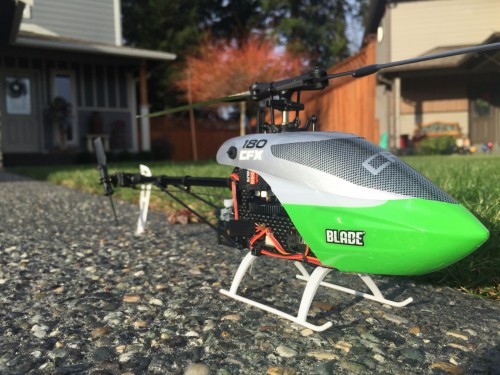
Through the first 5 fights I spent the majority of the time tuning the tail. Typically I would do my normal routine, which consists of a large right aileron roll while holding full collective but with this heli this method just wasn’t working. Every time I found that once I got the tail to slightly wag during the loop the stops would be way too hard and oscillate. I was able to turn down the main gain a bit to dial in the stops and the tail still held great through my normal routine. I know this isn’t the ideal gain but without going in to the advance settings this is what I had to do.
I think one of the main questions I had going in to this review is will I be able to actually 3D this helicopter in a controlled manner. This seems to be the million dollar question because what is the point if the heli can’t perform as advertised. Well I am happy to say that I was quite pleased with the 3D performance and I was able to do most of the maneuvers I do on my Warp 360 or Compass 7HV nearly every flight. This small heli did have its limitations. The first thing I noticed was with extremely aggressive flying. For example with tic tocs when I was trying to do them extremely hard and fast I could find the limitations on the motor power, and how crisp the head can stop. Now keep in mind this is when I was getting pretty stupid with the sticks. For the majority of pilots there isn’t going to be much that you won’t be able to do on this little guy.
Tuning
After spending about 15 flights on the heli in normal mode as it comes from the factory I was ready to start diving into the tuning a bit more, to see what this thing could really do. For those of you that don’t know what i’m talking about, this heli has an advance menu that lets you adjust the P, I and D gain on the head as well as the tail. If you are using a spektrum transmitter capable of telemetry you can see the gain values and change them right from your transmitter. I did not have this luxury when using an older DX7 but they do still allow you to access the menu. You just need to enter the advance mode then pay attention to the swash plate to determine which gain you are adjusting and roughly what the current value is.
The first thing I wanted to tackle was the tail gain. Like I mentioned before I was never able to get the main gain high enough because the stop gains were to high. Well now I could go in and manually adjust down the D gain to soften the stops. By this I found I was able to increase my main gain slightly with no negative effects. Lastly with the tail I noticed that on a punch out the tail would move a few degrees and not return to the starting position, telling me that the I gain was a little low. Luckily by increasing only the I gain I was able to solve the issue.
Overall once I was in the advance menu my traditional tail tuning techniques seemed to work just fine. I was able to do my full collective right aileron roll and max out the main gain until a slight tail wag developed. From here I used full collective stops and a punch out to finish the tuning in the I and D gain.
Next I tackled the head tuning to try and maximize head performance. Over all the head flew great out of the box but there were a few little bobbles that I wanted to see if I could tune out. The first changes I made was to decrease the P and the D gain. The reason I did this is I needed to figure out which gain were causing the bobbles, so I wanted to make sure both of them were low then slowly work up the P gain. As I increased the P gain I could clearly tell the head was getting more rigid and locked in. Then once I increased the D gain the heli really started to dial in. When tuning, the main maneuver I was using was a simple tic toc. When doing the maneuver I was being aggressive but making sure to maintain good collective control to keep the move clean.
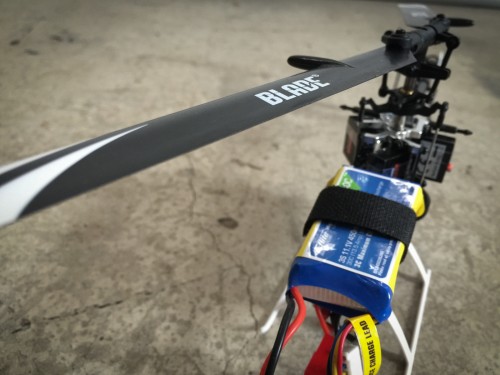
Once I noticed the bobbles starting to come back this is where I backed the P gain down just a touch and I left it. In addition I could really tell that as I was increasing the P gain not only were the tic tocs getting cleaner but the entire Heli was feeling crisper. It was refreshing to see the gains changing the flight characteristics exactly as you would expect. The last gain to look at was the I gain. To test the I gain I started flying very large maneuvers and watched the head tracking to make sure it was holding a consistent angle. Surprisingly the tracking was great and I didn’t need to tune the I gain at all.
In my opinion tuning this Heli was a great success. It was nice to find that the model flew well right out of the box and for some pilots this would be good enough. But for those who want the maximum performance there really was an added benefit to entering the advance menu and really go behind the scenes to manually tune the Heli. Coming from larger helis and having tuned numerous flybarless systems I was glad that Blade decided to include this capability.
Now that all of my gains were set I finally felt like it was time to see what this thing could do. I have to admit that this things flies pretty darn good. Personally it’s very hard for me to compare this heli to any other size in my fleet because when it boils right down to it the Blade 180CFX doesn’t fly like any other heli in my fleet. It honestly is like comparing apples to oranges. I can say that this heli flies extremely well when you consider the size of the model. I was able to perform nearly all of the 3D maneuvers I can do on my larger helis on the Blade 180CFX.
Although I can’t directly compare it to other helis I have flown, I can still give you my final thoughts on the capabilities and performance of this Heli. For one the Heli is very responsive probably due to the cyclic servos and the mechanics, as well as the high head speed it’s able to support. This responsiveness allows you to perform some advance maneuvers that I just don’t think you could do on some other micros.
Moving on the the tail. I was very impressed with how the tail tuned and the overall holding power and authority. In the past it seems that the tail was the largest issue with these small helis. It seemed like all the other parts were up to the challenge but the tail just couldn’t hold. Well with this Heli the tail is torque tube driven and works nicely. Giving the Heli the tail authority needed to be both responsive and hold heading.
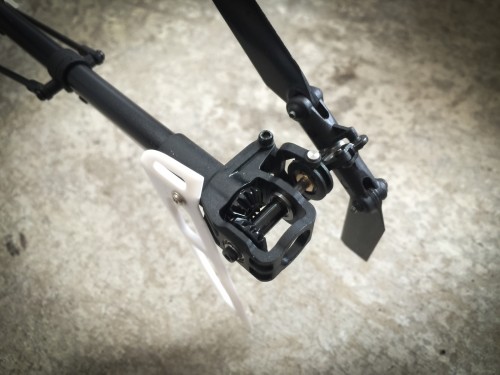
The one huge positive thing this helicopter has going for it, is the size. Never before have I been able to come home from work and immediately throw some batteries on the charger and get in some flying. This heli was the perfect size to fly right in the backyard or in a small field. Since the heli flies so stable it is easy to maintain complete control and fly in a box without the fear of hitting something.
When you are really pushing hard and trying to progress it can sometimes be hard to make the transition from the simulator to the real heli. I feel that that this little guy can step right in and for some people is going to be the perfect machine to fill that gap. It is low stress to fly and it is not intimidating. I can see this heli being a major factor to helping me get through the RCHN pilot proficiency program. I know that if I can pull off the move on the blade 180CFX then there is no doubt I will be able to do it on a 700 sized heli.
Durability
Currently I am starting to accumulate some flights on the model. Although I haven’t had a crash yet…knock on wood, I still want to talk about part durability. The main reason durability is important is because given the size of the Heli it is a huge pain to work on. So making sure the parts last and nothing wears out extremely fast is very important.
In general this Heli is built very stout, so things like the carbon fiber frame and other aluminum parts are fine. I am pleased to see that there is very little slop in the tail or head, and the little slop that is there doesn’t seem to affect the flight characteristics what so ever. The heli is still very smooth and all the bearings appear to be like new. Overall I am happy with how the model is holding up and don’t foresee having to replace anything until I break it by having an unscheduled interaction with the ground!
One of the last things I want to touch on are the upgrades for this helicopter. This review does not cover any upgrade specifically but I more want to talk about the possibilities. Since these smaller helis are so popular you can customize them heavily and make them your own. As for this Heli, Lynx has numerous upgrade parts as well as some bling. I’m excited that they have things like aluminum swash plate guides and upgraded torque tubes. In the coming months I hope to buy some bling to really make this Heli one of a kind!
Conclusion
When it comes down to it this heli is very versatile and it definitely has a spot in my fleet. I think that this is a great size and for me personally allows me to get in more flights per week then I would otherwise. This heli is the perfect size to work on those new moves without the pucker factor of a much larger heli. In addition with the advancements in flybarless systems and stability this heli flies much larger than it actually is.For me this is the perfect platform for fun and progression.
As always a huge thank you to Blade Helicopters and Horizon Hobby for making this review possible. I really did enjoy this Heli and I look forward to putting more flights on it in the coming months.
-Jessie
